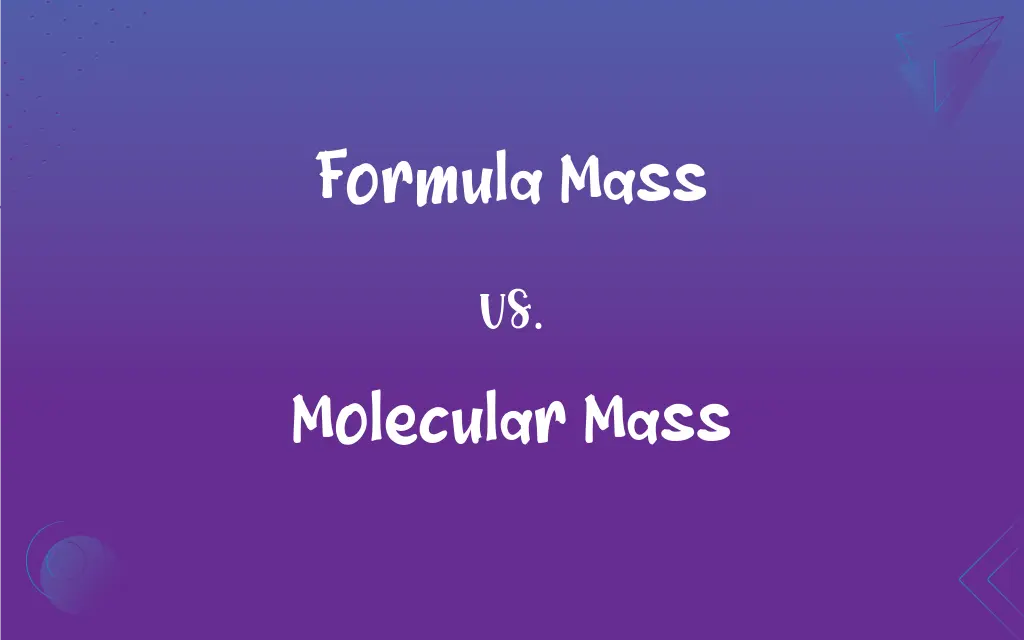Formula Mass vs. Molecular Mass: What's the Difference?
Edited by Aimie Carlson || By Harlon Moss || Published on November 16, 2023
Formula mass is the sum of atomic masses in a formula unit of a compound, typically for ionic compounds. Molecular mass is the sum of atomic masses in a molecule, typically for covalent compounds.

Key Differences
Formula mass and molecular mass are concepts in chemistry that refer to the mass of a single entity, be it a molecule or a formula unit. The formula mass pertains to the sum of the atomic masses of the atoms in a formula unit, which is most often associated with ionic compounds. For instance, in the case of sodium chloride (NaCl), one would calculate the formula mass by adding the atomic masses of sodium and chlorine. Molecular mass, on the other hand, deals with the sum of the atomic masses of the atoms in a single molecule, generally of covalent compounds. It describes the mass of one molecule of a substance.
In many instances, the terms might seem interchangeable, but they cater to different types of compounds. The formula mass becomes particularly relevant when discussing compounds formed from metal and non-metal elements, resulting in ionic bonds. These compounds don't have discrete molecules, so their smallest representative particle is a formula unit. In contrast, molecular mass is pertinent to covalently bonded compounds formed primarily between non-metals. Here, discrete molecules are the smallest representative units.
The importance of distinguishing between formula mass and molecular mass lies in understanding the nature of the compound in question. For instance, while one could technically calculate a "molecular mass" for sodium chloride based on its formula, it wouldn't be accurate since sodium chloride exists as a lattice of ions, not discrete molecules. Similarly, while water (H2O) has a formula that can be used to determine a "formula mass", it's more accurate to describe its molecular mass since it's a covalent compound with distinct molecules.
In practical applications, both formula mass and molecular mass give chemists valuable insights. The formula mass can aid in determining the amount of an ionic compound used in a reaction, while the molecular mass can help in gauging the amount of a covalent substance involved. By understanding the difference and significance of each, one can approach chemical reactions and analyses with greater precision.
Comparison Chart
Definition
Sum of atomic masses in a formula unit.
Sum of atomic masses in a molecule.
ADVERTISEMENT
Typical Compounds
Ionic compounds.
Covalent compounds.
Smallest Unit
Formula unit (e.g., ion pairs in a lattice).
Molecule (e.g., H2O molecule).
Example
Sodium chloride (NaCl).
Water (H2O).
Application
Used in calculations involving ionic compounds.
Used in calculations involving covalent compounds.
Formula Mass and Molecular Mass Definitions
Formula Mass
Essential for ionic compounds without discrete molecules.
Ionic compounds like KBr have a formula mass instead of a molecular mass.
ADVERTISEMENT
Molecular Mass
Pertains to the mass of covalent compounds.
Methane (CH4) has a molecular mass determined by one carbon atom and four hydrogen atoms.
Formula Mass
Calculated from the periodic table values for ionic compounds.
The formula mass of Na2O is twice the atomic mass of sodium plus the atomic mass of oxygen.
Molecular Mass
The weighted sum of the atomic masses in a molecule.
The molecular mass of H2O is calculated by adding the masses of two hydrogen atoms and one oxygen atom.
Formula Mass
Pertains to the mass of ionic compounds.
To determine the formula mass of calcium chloride (CaCl2), one must consider one calcium atom and two chlorine atoms.
Molecular Mass
Calculated from periodic table values for molecular compounds.
The molecular mass of O2 is twice the atomic mass of oxygen, as it consists of two oxygen atoms.
Formula Mass
The weighted sum of the atomic masses in a formula unit.
The formula mass of NaCl is the sum of the atomic masses of sodium and chlorine.
Molecular Mass
Represents the average mass of a single molecule.
The molecular mass of CO2 includes the masses of one carbon atom and two oxygen atoms.
Formula Mass
Represents the average mass of a formula unit.
The formula mass of MgO is derived from the atomic masses of magnesium and oxygen.
Molecular Mass
Essential for covalent compounds with distinct molecules.
Molecular compounds like NH3 have a molecular mass based on nitrogen and hydrogen atoms.
FAQs
What is formula mass?
Formula mass is the sum of atomic masses of all the atoms in a chemical formula, typically used for ionic compounds.
How is formula mass calculated?
By summing the atomic masses of all atoms in a compound's chemical formula.
Why is formula mass important?
It's essential for stoichiometric calculations in chemistry.
How does one distinguish between formula and molecular mass?
Formula mass is typically used for ionic compounds, whereas molecular mass is used for covalent molecules.
What units are used for formula mass?
The unit is atomic mass units (amu) or Daltons (Da).
Is molecular mass always greater than atomic mass?
For molecules with two or more atoms, yes. For monoatomic molecules, they're equal.
Is formula mass used for molecules?
Typically, no. Formula mass is generally used for ionic compounds, whereas molecular mass is for covalent compounds or molecules.
Can formula mass be fractional?
No, formula mass is an average and thus can be a non-integer value.
How is molecular mass determined?
By adding up the atomic masses of all the atoms present in a molecule.
Are there any common units for molecular mass?
Like formula mass, it's measured in atomic mass units (amu) or Daltons (Da).
Is molecular mass the same as molecular weight?
They're often used interchangeably, but molecular weight is technically a weighted average of all isotopic masses.
Is formula mass the same as molar mass?
For ionic compounds, they can be the same. Molar mass also considers the mass per mole of entities.
Is formula mass a scalar quantity?
Yes, it has magnitude but no direction.
Is molecular mass specific to covalent compounds?
Yes, it's typically used for covalent compounds or molecules.
Why is knowing molecular mass crucial?
It's essential for stoichiometric calculations, determining molecular formulas, and understanding molecular properties.
Can you give an example of molecular mass calculation?
For H2O (water), the molecular mass is twice the atomic mass of H + the atomic mass of O.
What's an example of formula mass calculation?
For NaCl (table salt), the formula mass is the atomic mass of Na + the atomic mass of Cl.
Can molecular mass be a decimal?
Yes, due to the presence of isotopes and their respective abundances.
What is molecular mass?
Molecular mass is the sum of atomic masses of all the atoms in a molecule.
How does molecular mass relate to moles?
The molecular mass in grams of a substance is equal to one mole of that substance.
About Author
Written by
Harlon MossHarlon is a seasoned quality moderator and accomplished content writer for Difference Wiki. An alumnus of the prestigious University of California, he earned his degree in Computer Science. Leveraging his academic background, Harlon brings a meticulous and informed perspective to his work, ensuring content accuracy and excellence.
Edited by
Aimie CarlsonAimie Carlson, holding a master's degree in English literature, is a fervent English language enthusiast. She lends her writing talents to Difference Wiki, a prominent website that specializes in comparisons, offering readers insightful analyses that both captivate and inform.































































